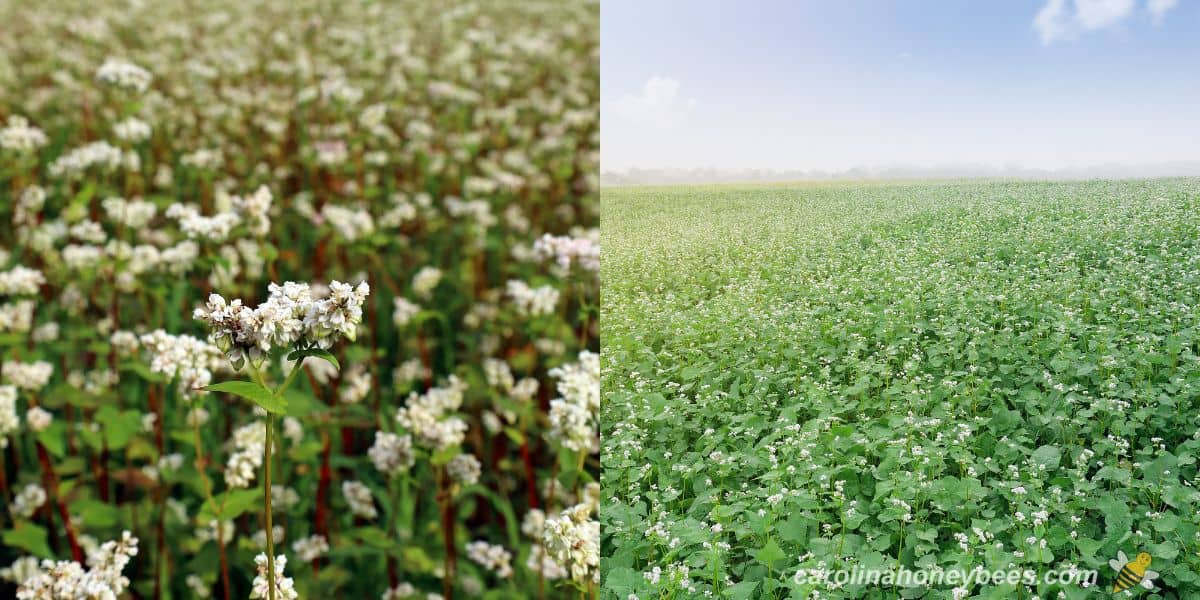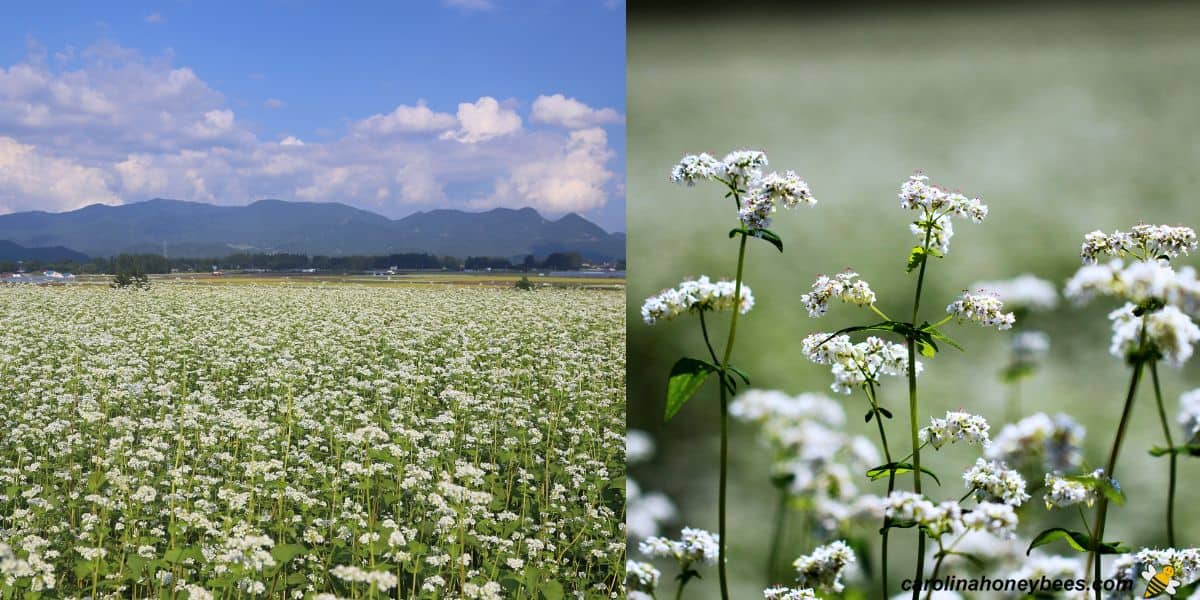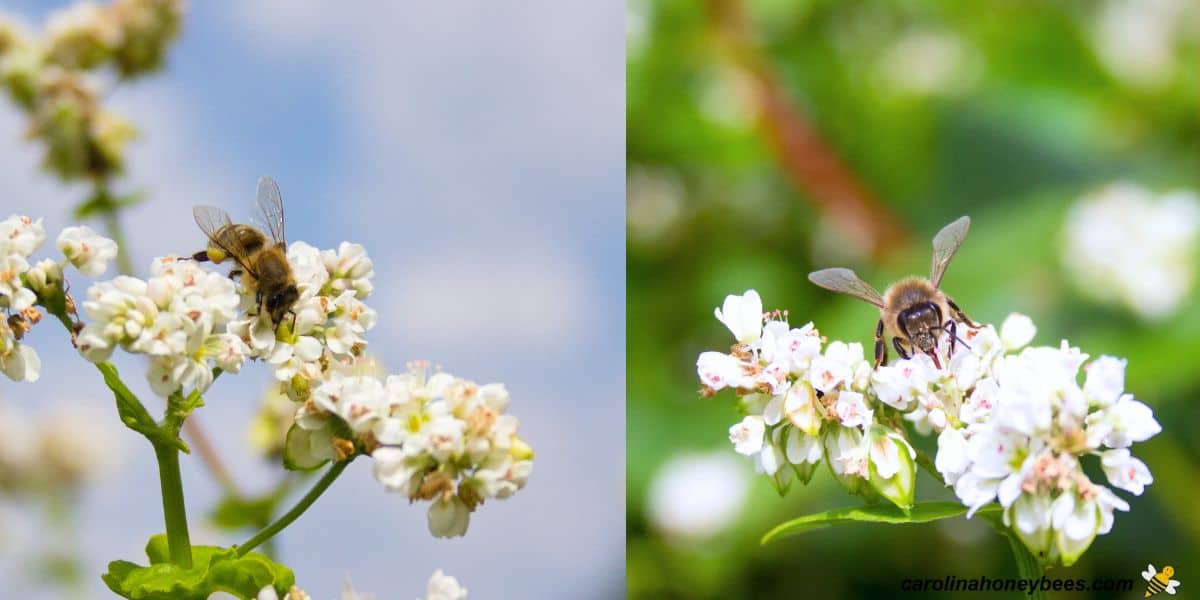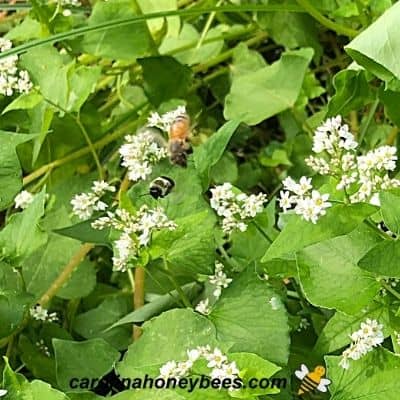Buckwheat for Bees
Many homeowners and beekeepers are surprised to learn that you can plant buckwheat for bees. This is yet another way to provide a different source of nectar and pollen. These small food plots can be very beneficial in areas where late Summer is often hot with reduced nectar sources. Here, I will share the benefits of giving your bees some buckwheat blooms to visit. And how it helps all area pollinators.

During most summers, I plant a small section of buckwheat in my garden. Most commonly this is done after I harvest my early corn or other vegetables are done. I consider this a part of my bee friendly garden project – even though it takes place in my garden.
Benefits of Planting Buckwheat for Your Bees
Buckwheat (Fagopyrum esculentum) is a pseudo-cereal crop. It is not a true grain. But, the seed can be hulled (they are called groats) and cooked like cereal or made into flour.
You’ve heard of buckwheat flour, right? Even though it can be a cash crop for farmers, it is not widely produced in the United States any more.
Today, buckwheat is used primarily as a cover crop. Fields of buckwheat protects the soil from erosion during the time when it is bare – between crop planting for farmers.

Do Bees Like Buckwheat?
Honey bees love buckwheat though mine don’t forage on the plants all day. Buckwheat flowers only produce a lot of nectar early in the morning.
You will see a variety of bees, wasps and more on the blooms. Later, foraging bees switch to other nectar sources.
Though frost tender, the plant is a fairly dependable honey plant – even though it only produces nectar in the morning.
Buckwheat fills a special need for beekeepers who live in regions with a late Summer nectar dearth. Hot dry weather causes many plants to produce less nectar – or none at all.
Because buckwheat is a fast grower, it can fill this gap producing flowers only 30 days from planting. You can make several plantings spaced a few weeks apart to create a longer bloom time.

Is Buckwheat Good for Other Pollinators?
There are many reasons to include a small patch of buckwheat if you have the space. This fast-growing plant provides nectar and pollen for many insect species.
You will find honey bees, bumble bees, butterflies, moths and many native bees visiting your buckwheat flowers.
After frost, the dead plants can be left to cover the ground during the winter. This adds organic material to the soil and helps promote good soil for next year. This provides a place for beneficial pollinators such as bumble bee queens to overwinter – don’t till.

Characteristics of Buckwheat Honey
Since, it can be a honey plant – lets look a bit closer at buckwheat honey. While easy to grow, the plants produce the most nectar under good growing conditions.
A large field of buckwheat flowers can result in a decent honey crop in some regions. However, most beekeepers do not grow it with that expectation.
Be prepared that buckwheat honey is a bit different than the normal golden honey bears you see in the grocery. This nectar results in a very dark colored honey that has a strong odor.
Some people compare it to molasses. The flavor is too strong for all but the most ardent honey lovers – ( I personally do not care for it) but dark honey often contains more minerals than light colored.
While not the favorite of honey connoisseurs, the bees seem to find it quite tasty. And the unique flavor appeals to some consumers. It is rich in antioxidants and is commonly used in honey cold relief recipes.
If you do harvest honey for yourself, do not be alarmed if it crystallizes. In fact, it tends to do so faster than some varieties. Keep that in mind when choosing how to store your honey jars.
For the bees, honey produced from buckwheat is a good addition to their Winter food stores. A colony is always best suited by having a wide range of food sources in the hive. This gives them more types of vitamins, minerals etc.

Growing a Plot of Buckwheat for Honey Bees
Whether you have acres of space of just a small backyard plot, growing buckwheat is very easy. It is not bothered by many pests or diseases and forms a dense patch that crowds out weeds.
It will grow almost anywhere and even tolerates some shade. Flowers appear within a month of planting. This is one of the major benefits in my opinion.
Buckwheat goes to seed about 10 weeks after planting. Again, this is why you may plant more than once if you wish.
Personally, I mow my plot before seeds form to control the number of seeds that will come up later. It is not a invasive plant but I do have a few volunteers plants come up next year – no worries. Some gardeners mow it and till in the green matter.

Do Bees Always Visit Buckwheat Flowers?
Because it only produces nectar early in the day, some gardeners include a few rows of sunflowers that bees like into the buckwheat fields. This gives the honey bees an all-day buffet.
What if you plant a plot and those winged girls ignore it? Could this happen? Yes, it could. Whether or not your bees will forage on your buckwheat plot depends on what else is available. If the scout bees find a better nectar source, they will visit it instead.
This post may contain affiliate links. As an Amazon Associate, I earn from qualifying purchases. Please read my disclosure.
How to Plant Buckwheat Seeds
Buckwheat seeds can often be found for sale at a local feed store. Hunters often use it in food plots for deer. You can also order it online.
If you have any left over, store it in the freezer and use it next year. I find the seed to be dark, shiny and quite appealing.

I prefer to plant my bee buckwheat plot after the main honey flow. This prevents dark honey from being included in my harvest.
Here, I often plant in mid-late July, after the Sourwood flow has ended. This is the time when any corn has finished in the garden. Buckwheat makes a nice cover crop that is pretty and feeds my girls.
You may plant up to 6 weeks before last frost for late fall nectar. This is a good compliment to goldenrod nectar for the colony.
- very little tilling is necessary to germinate their smooth dark seeds. I don’t even bother clearing out all the Bermuda grass
- after exposing some soil, scatter the seeds across the surface
- then drag a leaf rake across the area
- for a small area, I would then wet the plot to get it off to a good start.
- within 7 -8 days, you should see seedlings.

Tending Your Buckwheat Plot
Buckwheat is a really fast-growing source of food for bees. The plants reach knee-high level quickly and before long you see flower buds. There may seem to be a lot of grass in my plot but it is okay – the bees don’t care.
Over the course of several weeks, the plot will thicken up and become quite lovely. The better job you do of uniformly spreading the seeds – the better it will look.
However, sometimes things happen – a deer will decide to lay down in the middle or a freak thunderstorm will make it all lay over anyway!
This bee plant is very much a hands off project. This is a wonderful thing here in the South where is it hot as “you know” in the Summer.
I rarely water the buckwheat plot after that first day. Even a small amount of rain will keep things moving along. This is a low maintenance crop.
Then, just a few weeks later – as if by magic – you will here a buzz in the buckwheat patch. Once you arrive, you see many different types of insects enjoying the feast.
Never fear, there is enough to go around. Bumble bees of all sizes, honey bees, and even though wasps are different than bees they visit the flowers too. The plant will provide food for several weeks or until the first frost.

FAQS
Buckwheat provides both nectar and pollen for hungry bees.
Everyone has different tastes but buckwheat makes a dark bold tasting honey that some people love.
Yes, it is a beneficial plant for honey bees and many other pollinators.
Produced in several parts of the world, some of the best buckwheat honey comes from Ontario and Quebec.
The answer is honey bees. Though many pollinators are attracted to the white flowers, honey bee love them.
Oh yes, buckwheat readily reseeds itself. That is why I mow my plot before many of the seeds form. This results in relatively few coming up next year.
Final Thoughts
Must you have a large area to enjoy this experience? No, not everyone has the space to plant a large field.
However, if you have a little space or even a few large containers on the patio, consider planting buckwheat for bees in your backyard.
While the reseeding can be an issue, planting a small area of buckwheat is a natural way to provide some much needed late summer nectar for the bees. It offers a nice alternative to sugar water because it is real nectar.
It is a very enjoyable experience to watch the busy insects at work. And besides, how many people do you know who can honestly say that they have grown buckwheat?

